From The Green Hornet to Peter Gunn to My Favorite Martian and MORE…
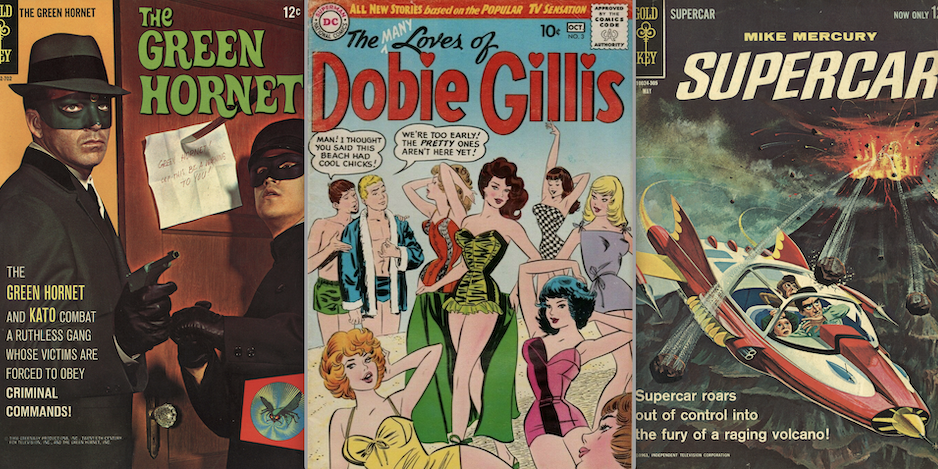
—
UPDATED 9/11/23: September is the traditional start of the TV season. Or, at least it was in the days of three networks. So it’s the perfect time to “reprint” this April 2022 piece by Peter Bosch, who has since become a 13th Dimension regular. (This was his first column for us!) And here’s some good news: Peter’s hard at work at a sequel to this book — it’s about classic movie-adaptation comics! So dig this and its companion piece, 13 GROOVY TELEVISION COMIC BOOKS OF THE 1970s. Click here. — Dan
—
TwoMorrows has another groovy illustrated comics history book coming your way this month: American TV Comic Books: 1940s-1980s, by Peter Bosch. (Click here to order!)
As the title suggests, the oversize trade paperback covers a very specific genre with a level of detail that brings to the fore the artistry and creativity that went into comics often sniffed at because they were licensed properties. We’re talking creators like Alex Toth, John Buscema, Russ Manning and many other comics heavyweights.
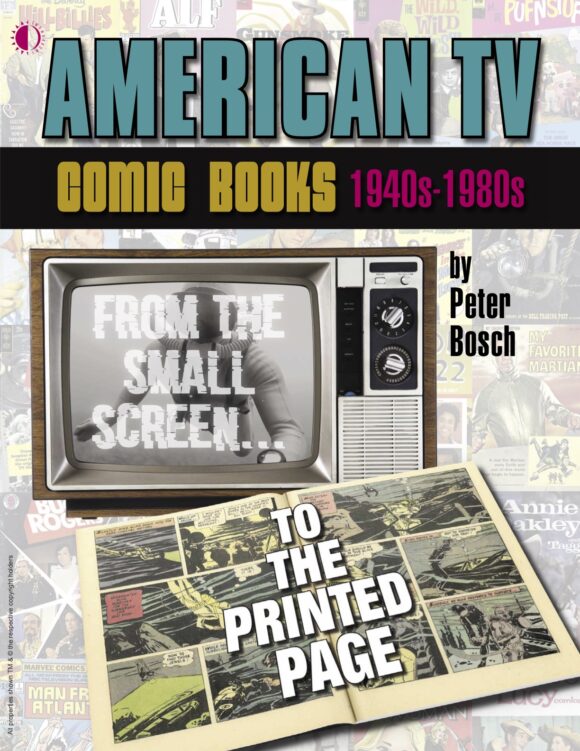
Anyway, with the book due out April 20, we’ve invited Peter to put together a swingin’ gallery of 13 GROOVY TELEVISION COMIC BOOKS OF THE 1960s, complete with commentary. Oh, and next week, we’ll bring you a second feature on the ’70s! (UPDATED: And here it is!)
Right on.
—
By PETER BOSCH
Comic books based on television shows have been around since 1949 and have been a favorite of mine since I first watched TV as a kid. I was born in the mid-1950s, not long after TV became a staple in everyone’s living room, and many of my fondest memories as a child of the Sixties were that decade’s great TV shows. At the same time, I also developed a second love in my life… comic books! And how delighted was I when I discovered on the comic rack that the two combined into one.
Below are 13 TV comics from that period. Some are fond memories of a happy child. The rest are looked at now with an adult’s appreciation of the artists in them:
—
77 Sunset Strip (Four Color #1066, Jan.-Mar. 1960, Dell). 77 Sunset Strip was an ABC-TV private detective series starring Efrem Zimbalist, Jr. and Roger Smith, but their lead roles were soon overshadowed because the young female public swooned over Edd Byrnes who played “Kookie,” the hip-talking, hair-combing attendant of the parking lot next door to the detective agency.
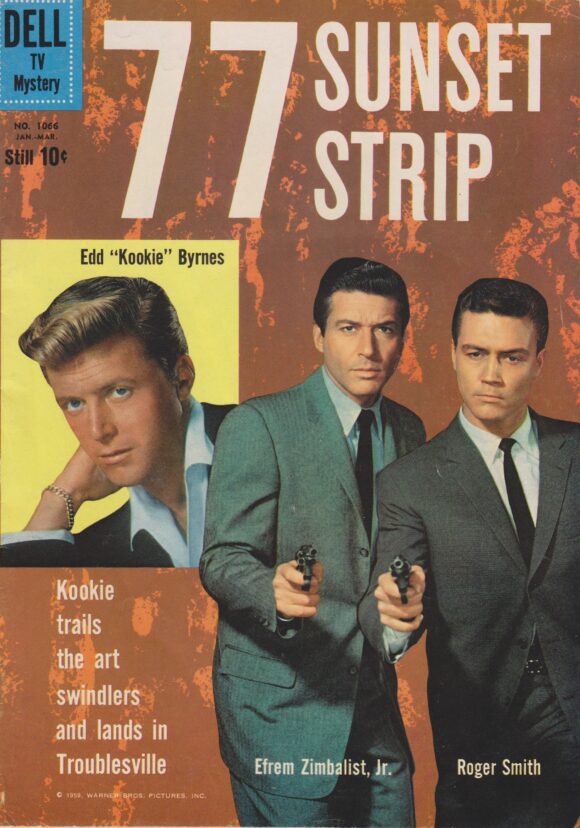
Dell Comics’ first 77 Sunset Strip issue tying in to the show was dated January-March 1960 and such was Byrnes’ popularity that a photo of him appeared prominently alongside Zimbalist and Smith on its cover. (He was also on all of the six Dell comics covers after that, as well as two Gold Key issues). What makes this issue special is Alex Toth’s art, a delight from beginning to end. Toth even got to draw Kookie holding off a villain with a bit of swordplay a la Zorro, Toth’s comic masterpiece from a few years earlier.
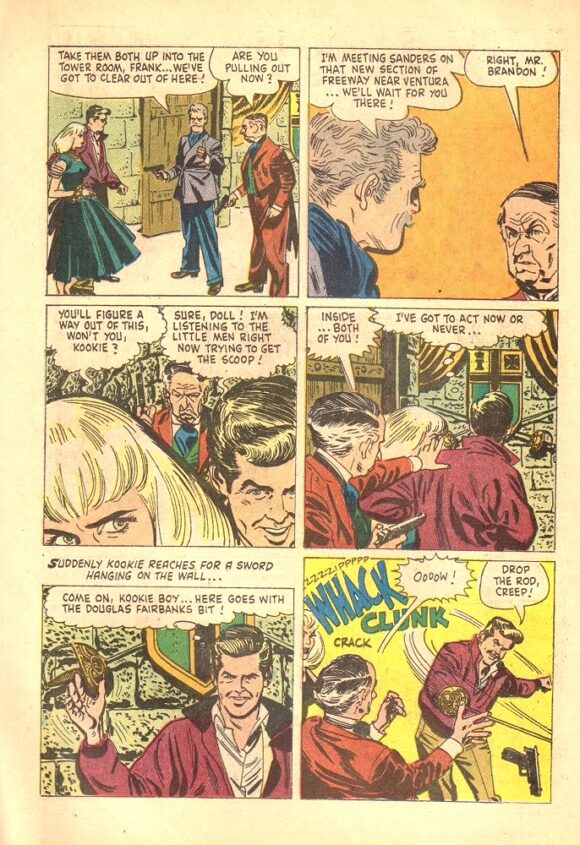
—
The Deputy (Four Color #1077, Feb.-Apr. 1960, Dell). Prior to his great Marvel superhero work, John Buscema drew several TV and movie comic book adaptations, including this great issue of The Deputy from Dell Comics, based on a 1959-61 NBC television series starring Henry Fonda and Allen Case.
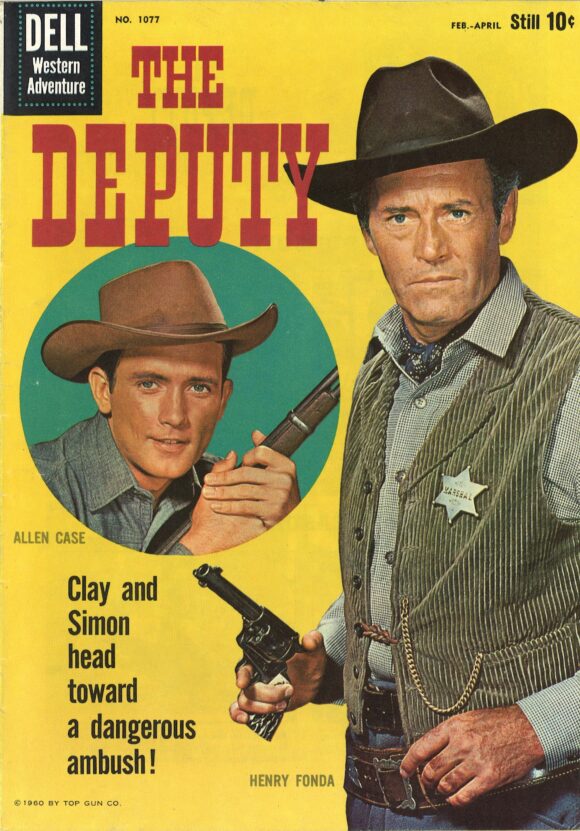
Buscema’s art here and on the second Four Color issue of The Deputy (#1170) was strong, a forerunner of his superb art on The Avengers and other titles.
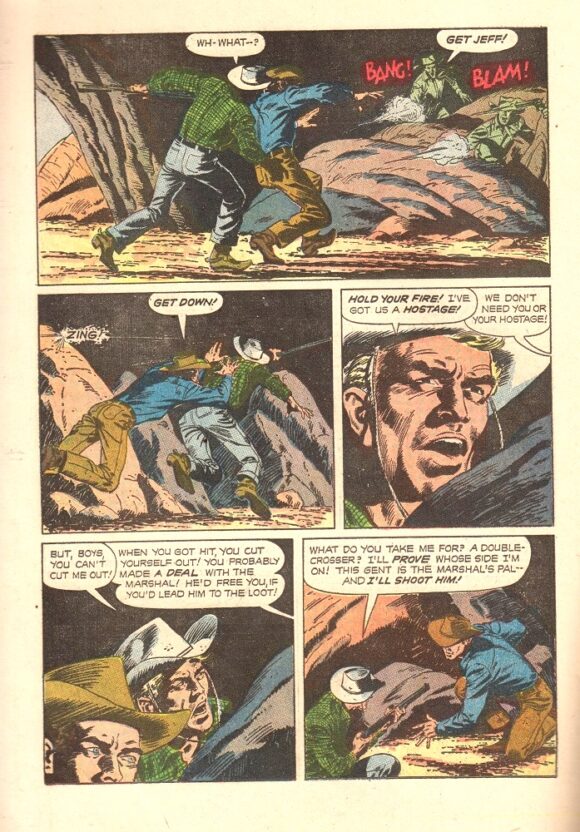
—
Peter Gunn (Four Color #1087, Apr.-June 1960, Dell). A great Henry Mancini jazz theme introduced one of the greatest private eye series on television, Peter Gunn, starring Craig Stevens. Despite the popularity of the series (it aired for three seasons, from 1958 to 1961), Dell only released one comic issue based on it. However, artist Mike Sekowsky delivered a one-two punch, with heavy-duty action sequences and excellent representations of the lead actors in it.
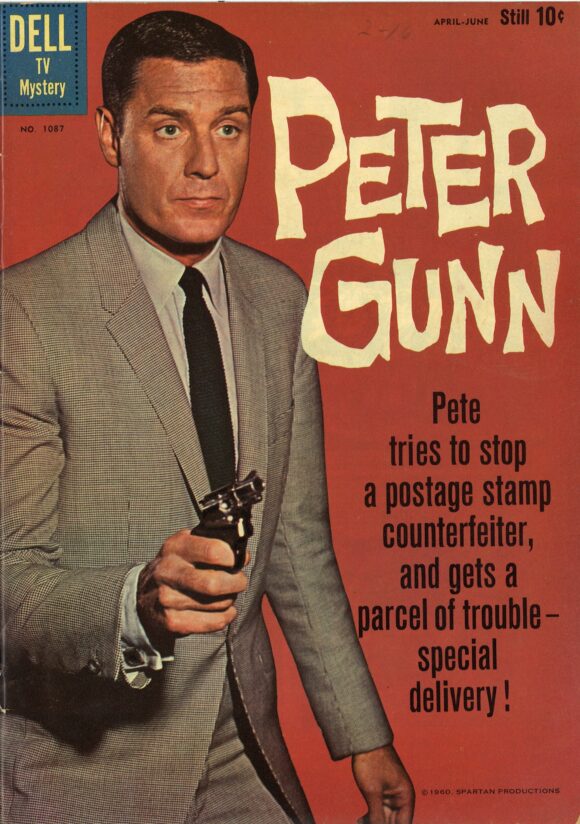
(Sekowsky had experience in this field, before and after Peter Gunn, drawing TV-based comic books such as The Rebel, Gunsmoke and The Man from U.N.C.L.E.)
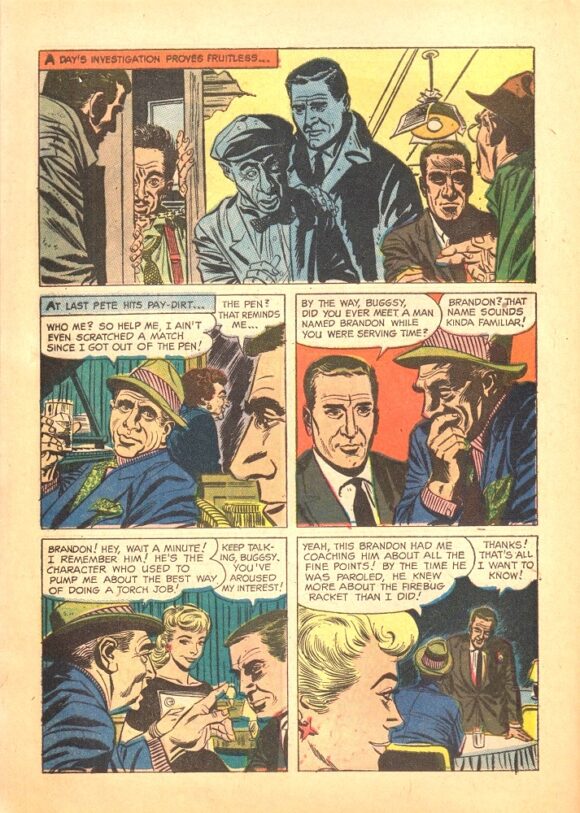
—
The Many Loves of Dobie Gillis #3 (Sept.-Oct. 1960, DC). One of the most popular sitcoms of the late 1950s and early 1960s was CBS’ The Many Loves of Dobie Gillis, with Dwayne Hickman as the girl-happy Dobie and Bob Denver as his beatnik buddy, Maynard G. Krebs. DC Comics was quick to license the series for comics and the first issue (May-June 1960) featured a cover with Dobie in front of Rodin’s “The Thinker” statue, a regular stop for him on the show to discuss with the television viewers his current frustration, usually women. The comic book series featured Dobie with so many new female loves that only one artist could do them all justice and that was Bob Oksner. The women he drew were not just beautiful, they were dazzling heartstoppers.
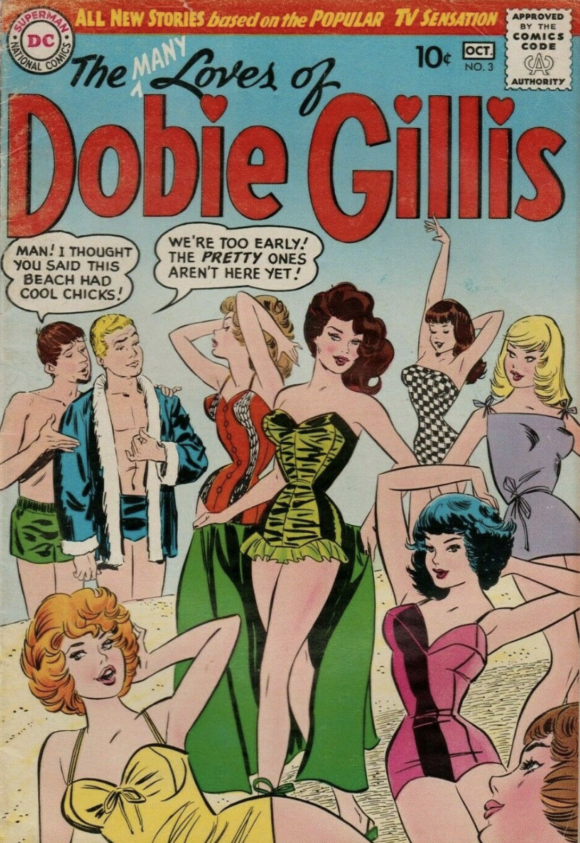
—
Laramie (Four Color #1284, Feb.-Apr. 1962, Dell). The stories on the Laramie television series from NBC usually revolved in or around the farm that served as the temporary stopover for stagecoach passengers.
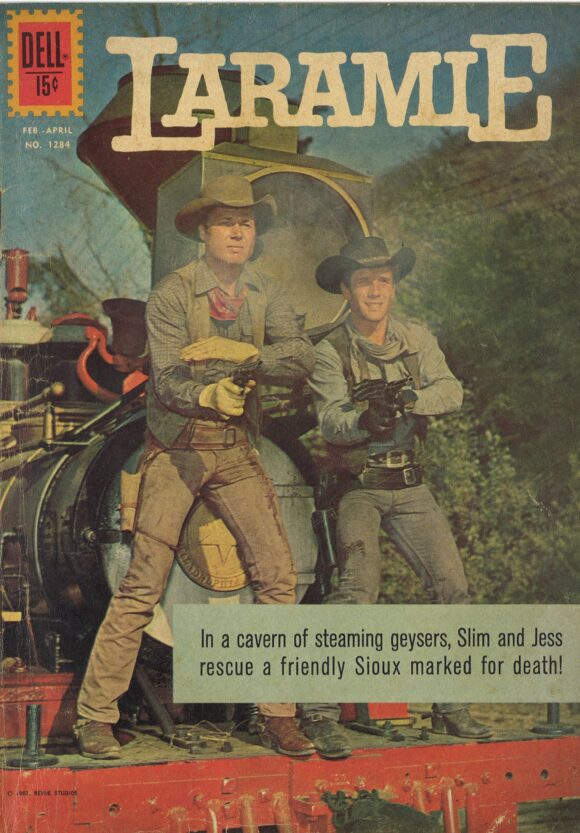
Dell’s comic tie-in to the program, which starred John Smith and Robert Fuller, featured four issues (mostly within the fold of Dell’s Four Color title) that contained excellent art by Gil Kane and Jack Sparling but this issue was the finest, with some of Russ Heath’s most striking Western comics art ever.
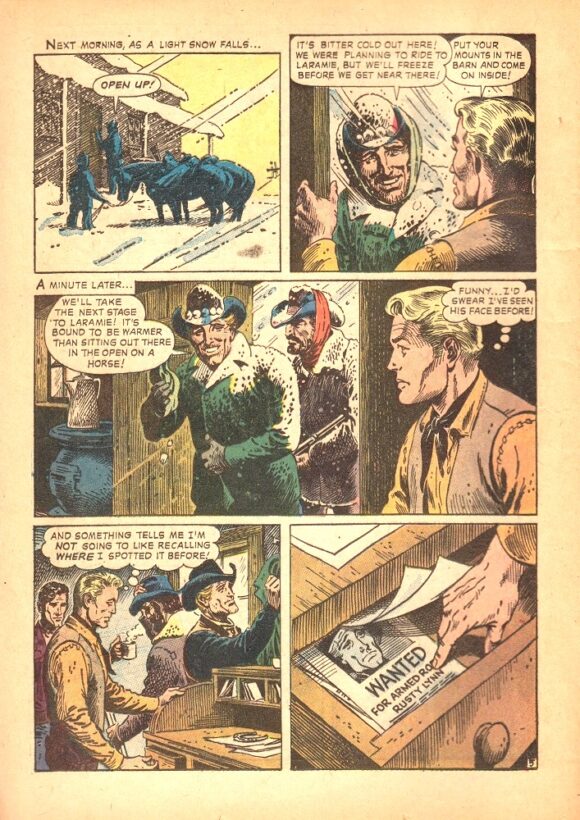
—
87th Precinct (Four Color #1309, Apr.-June 1962, Dell). Robert Lansing starred as Police Detective Steve Carella in the one-season (1961-62) NBC series 87th Precinct, which was based on Ed McBain’s novels.
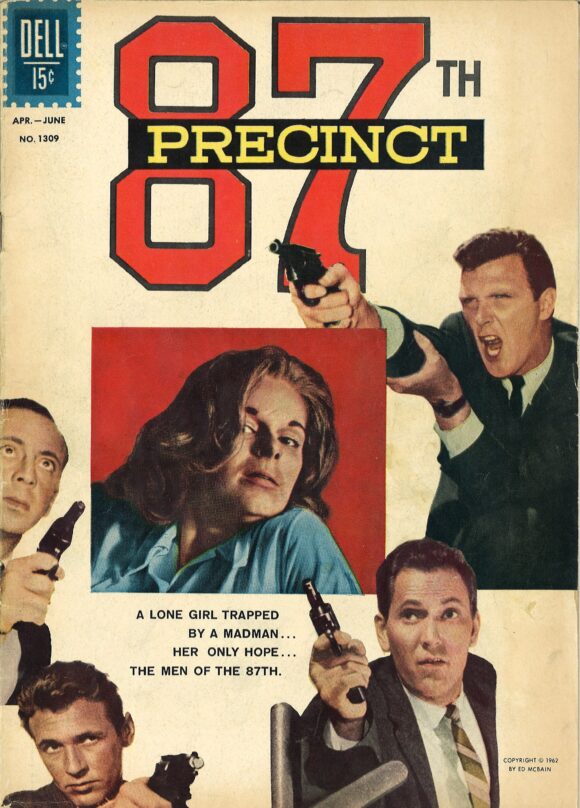
Dell published two issues, but the first issue was the real standout because it featured Bernie Krigstein’s final comic book art — and he went out with a tale of an insane artist who murdered his subjects. That the artist was also blind led to some of the wildest art Krigstein ever committed to comic book pages.
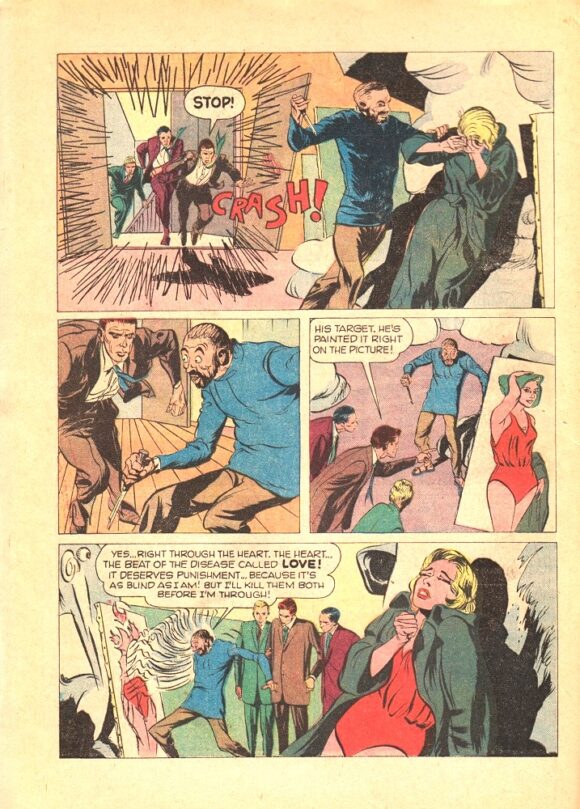
—
Ben Casey Film Stories #1 (1962, Gold Key). This Gold Key issue has a unique place among 1960s comic books because it was the only television tie-in issue at that time to feature TV-film frames laid out in comic book fashion instead of drawings.
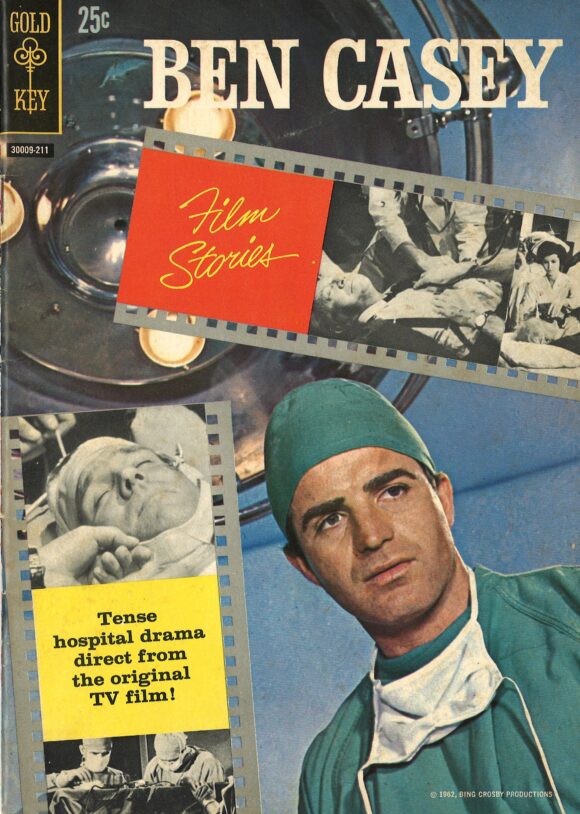
The photo comic adapted two episodes from the television program starring Vince Edwards, but it was an experiment that did not succeed. Gold Key was going to do a similar issue for “Gunsmoke” but it was never published.
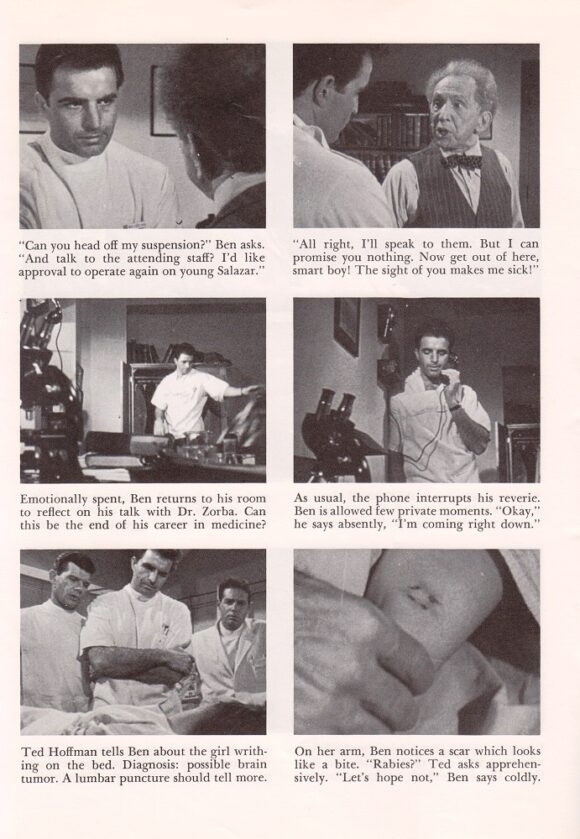
—
Supercar #3 (May 1963, Gold Key). This was likely the earliest TV comic I purchased when I was very young, so it has always had a warm spot in my heart. Supercar was the first marionette adventure TV series by England’s Gerry Anderson and featured test pilot Mike Mercury and his friends using the amazing vehicle of the title to help people and defeat bad guys. The four-issue series from Gold Key was an excellent adaptation of the look of the TV program.
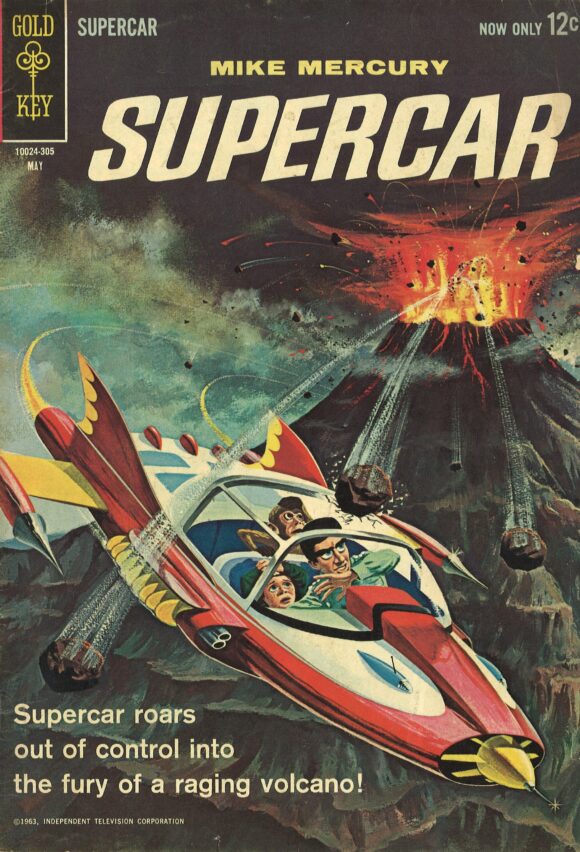
—
My Favorite Martian #1 (Jan. 1964, Gold Key). Russ Manning was assigned to draw the first of nine Gold Key comics based on the My Favorite Martian TV sitcom. It was an unusual choice considering Manning was great at drawing dramatic TV adaptations such as Sea Hunt, Rawhide, and 77 Sunset Strip for Dell and Gold Key.

However, with this, he also proved he could draw comedy in the retelling of the first TV episode with reporter Tim O’Hara (Bill Bixby) helping a Martian (Ray Walston) after his spaceship crashed on Earth.

—
The Scarecrow of Romney Marsh (unnumbered, Apr. 1964, Gold Key). One of the best productions of Walt Disney’s Wonderful World of Color was the exciting three-episode The Scarecrow of Romney Marsh in 1964, which starred Patrick McGoohan as a vicar by day and the mysterious Scarecrow, a masked leader of smugglers, by night.
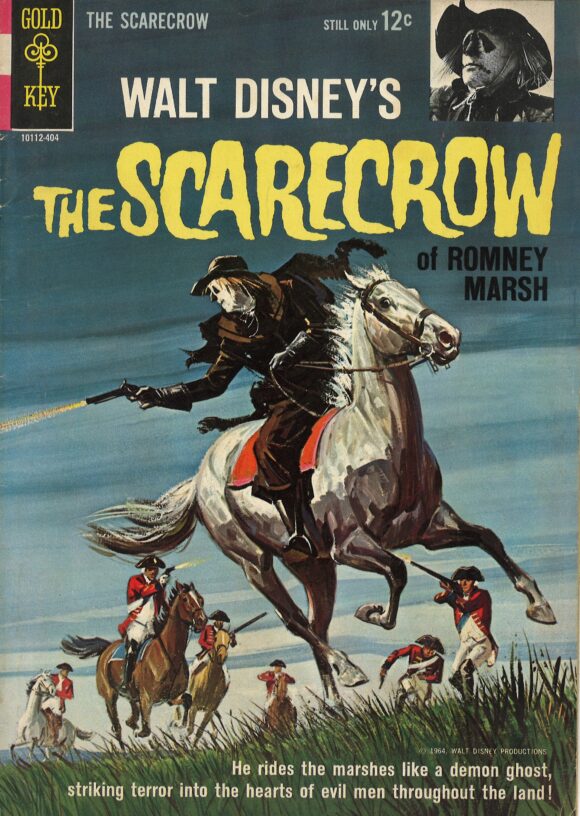
Dan Spiegle did a masterful job drawing the 32-page story set in 18th-century England. Gold Key, Disney, and Spiegle followed up with two more issues in 1965, with the title reduced to The Scarecrow and including original stories.
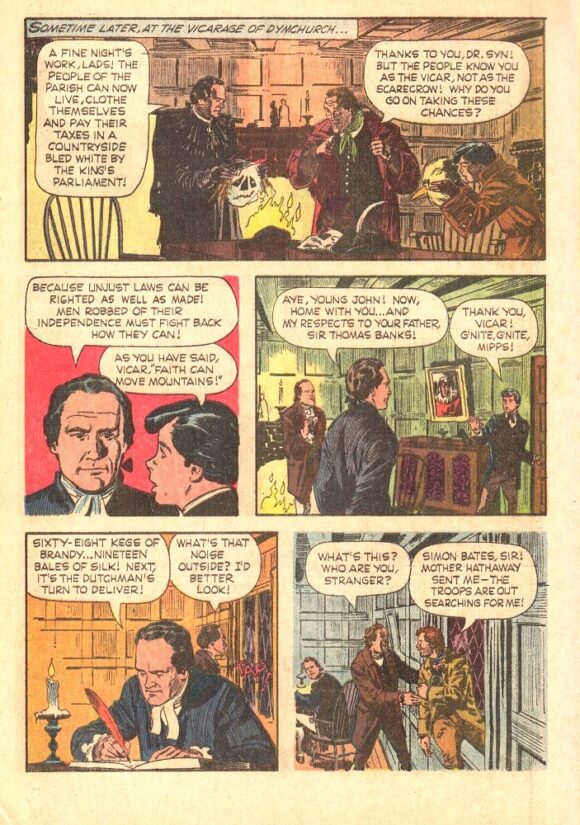
—
Wagon Train #4 (Oct. 1964, Gold Key). The long-running TV series (1957-1965) about wagon masters taking homesteaders West led to a comic book tie-in of 13 issues from Dell Comics between 1958 to 1962. However, the artwork for the issues could have been much better. In 1964, Western Publishing began a new Wagon Train tie-in series under their Gold Key imprint and they brought in Warren Tufts, a masterful artist whose experience included writing and drawing the Western newspaper comic strip Casey Ruggles for nearly seven years, as well as illustrating comic book versions of the TV shows Zorro, Rawhide, and The Rifleman.
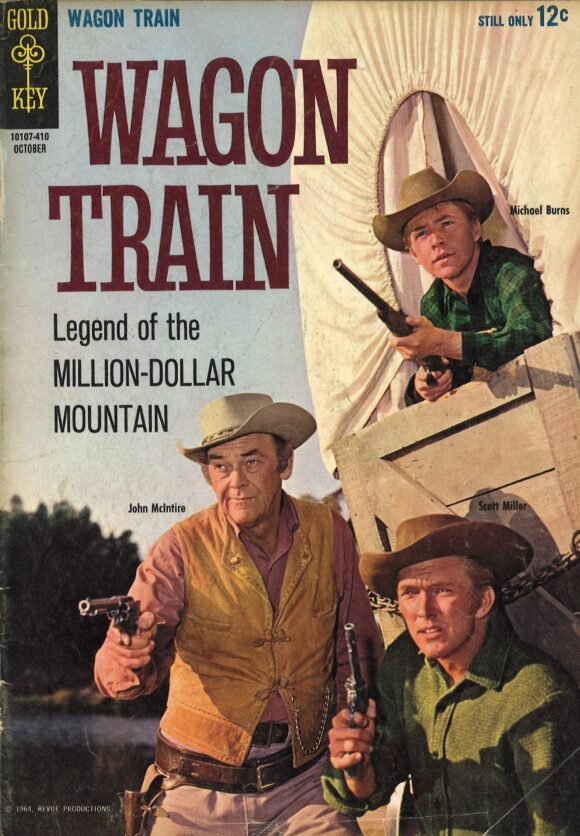
The new comic series was exceptional and worthy of the television program.
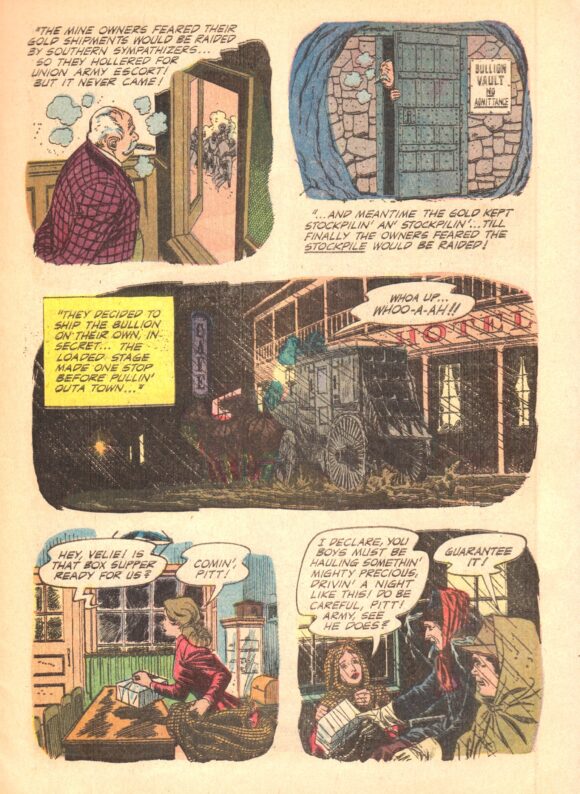
—
Action Comics #345 (Jan. 1967, DC). Candid Camera was one of the funniest television programs of the Fifties, Sixties, and Seventies. Host Allen Funt had outrageous gags secretly set up in public to see how the ordinary citizen would react to them. It led to a lot of good-hearted hilarity for the home viewer, and a secret desire to one day have Funt say to them, “Smile, you’re on Candid Camera.” Action Comics #345 was a silly tie-in, but it was fun at the same time.
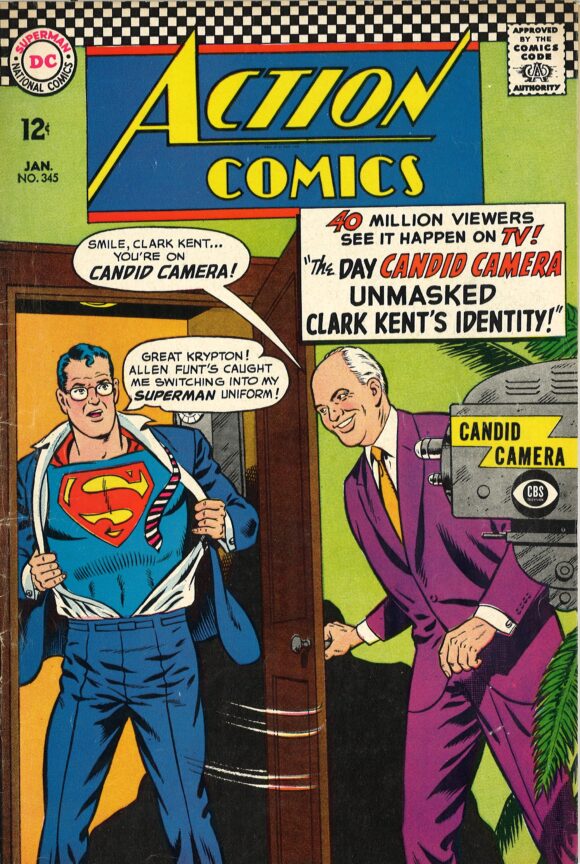
—
The Green Hornet #1 (Feb. 1967, Gold Key). The Green Hornet TV series made its debut on ABC in 1966 and had several things in its favor. It was played seriously (as opposed to its sister program Batman), had a good cast of Van Williams as Britt Reid/Green Hornet and Bruce Lee as Kato, a great car (the Black Beauty), and Al Hirt playing a jazzed-up “Flight of the Bumblebee.” Unfortunately, it failed in the ratings and was yanked after just one season.
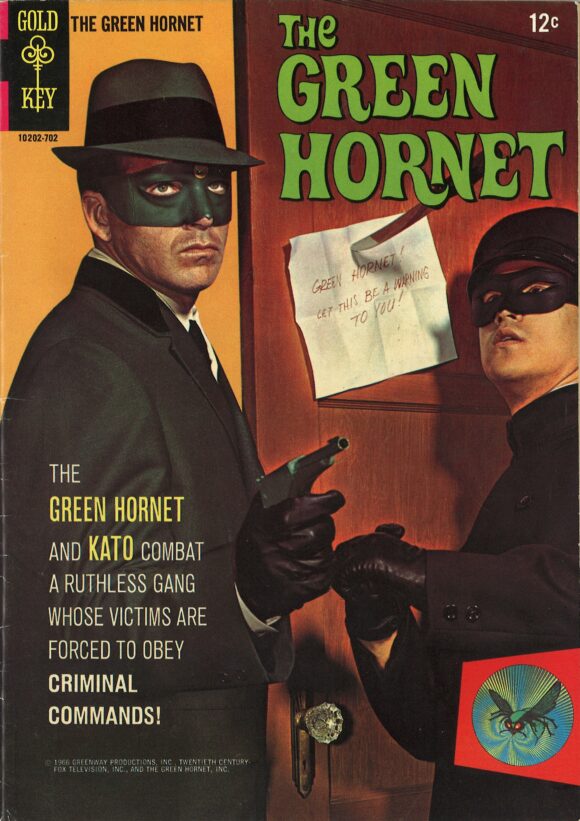
On the plus side, the three-issue Gold Key series published during that time was wonderfully drawn by Dan Spiegle, with plenty of action sequences and nighttime scenes in the first issue, bringing over the feeling of the television program. (Each of the three issues also had excellent photos of Van Williams and Bruce Lee on the covers.)
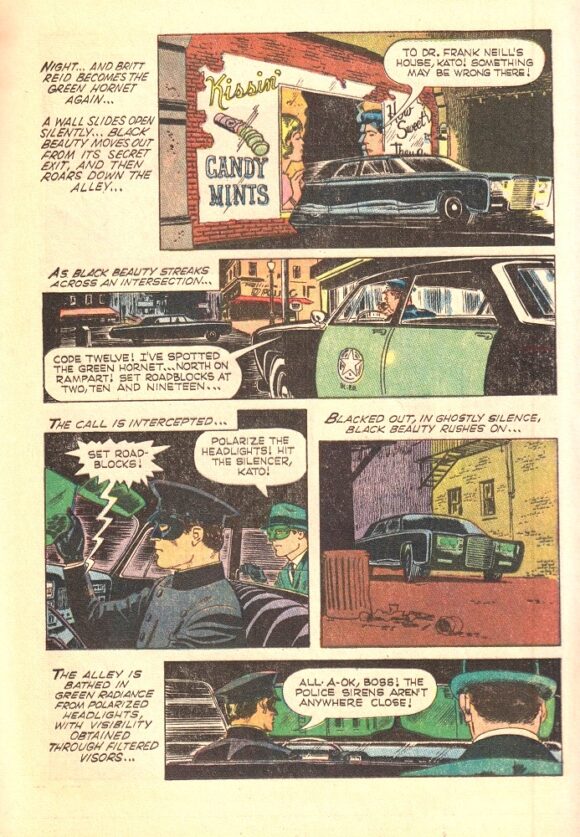
—
American TV Comic Books: 1940s-1980s, by Peter Bosch, is due April 20. The 192-page paperback lists for $29.95. It will be available through comics shops and booksellers. You can also order it directly from TwoMorrows. (Click here.)
—
MORE
— 13 Groovy TELEVISION COMIC BOOKS of the 1970s. Click here.
— PAUL KUPPERBERG: My 13 Favorite 1960s Gold Key Comics TV Adaptations. Click here.

April 9, 2022
That is some great stuff. As much as I love the actual shows, I just really love the occasional painted covers of certain TV shows’ comic versions even better. That Scarecrow of Romney Marsh cover is fantastic! Those 3 issues have been on my want list for years. I have the TV series on both DVD and Blu-ray.
April 9, 2022
Was the first TV comic based on the Lone Ranger? I believe the comic series began in 1948, and after the show became a hit they started featuring Clayton Moore and Jay Silverheels on the covers and began drawing the characters to look like both. Is that right? I may have to get my hands on that book.
April 10, 2022
Hi, robbushblog, it’s a great question. And it was the important starting point of my book. The first TV comic book tie-in was “Suspense” #1 (Dec. 1949), based on the radio and TV program. It was published by Marvel (not be confused with their “Tales of Suspense” title). As to “The Lone Ranger,” while the TV series was on the air, Dell Comics did have a number of excellent painted covers with the Ranger resembling Clayton Moore, but the first photo cover of Moore for the comic book title was “The Lone Ranger” #112 (Oct. 1957). However, Dell did publish an earlier one-shot comic that had cover photos of Moore and Jay Silverheels, “The Lone Ranger Movie Story” (Mar. 1956), but it was tied to the 1956 theatrical film, not the TV series.
April 10, 2022
Thanks for the reply, Peter! I was born 25 years later, so I was just guessing.
April 9, 2022
Love to have Disney release Scarecrow on Disney Plus and/or have it out on blu-ray DVD!!
April 9, 2022
You can get it on Blu-ray through the Disney Movie Club.
April 11, 2022
Who doesn’t love a good microcosm? The early 1960’s television comic book adaptations were eye catching on the spinner rack because many had a color photo of a program that most everyone saw weekly in black and white. By decade’s end, color TV sets had become more prevalent, Green Lantern/Arrow had a syringe on it’s cover, and most TV adapted comics (save for the likes of The Partridge Family or Scooby-Doo) were long gone.
April 11, 2022
And Gold Key’s Star Trek series ran until 1979.
April 11, 2022
robbushblog, my book covers every TV program (over 300 of them) from the 1940s to 1989 that had a comic book created based on it. The “Star Trek” entry starts with Gold Key in 1967, and then continues when Marvel and DC got the rights. (By the way, I have one more article coming to this site this week, and it covers 13 of my favorite TV-related comics from the 1970s. In it, I bring up the ST comics from Gold Key. Though the Gold Key ST comic started in the late 1960s, the particular issue I chose to highlight was published in the 1970s and so I made an exception this one time.)
April 11, 2022
I’m looking forward to reading your article. Thanks!
April 11, 2022
Hi, Chip. While TV comics slowed down in the 1970s and 1980s, it was also reflective in every comic book genre for every publisher, including the field of superheroes. In the 1990s, there was a resurgence of new TV comic tie-ins, thanks to new independent comic publishers. By comparison, the 1990s doubled the previous decade’s output of brand new titles. In the 2000s, over 30 new TV programs were adapted to comics, and from 2010 to 2021 there were over 50 new TV series tie-ins. And by “50”, I am not referring to the number of issues published; I am talking about 50 different TV series. TV-comics are very much still with us.